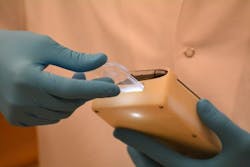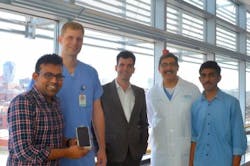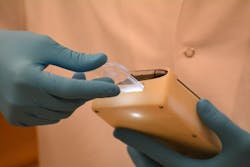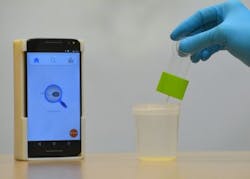Smartphone attachment screens for male infertility with 98% accuracy
Recognizing that current standard methods for diagnosing male infertility can be expensive, labor-intensive, and require testing in a clinical setting, a team of researchers from Brigham and Women's Hospital (BWH) and Massachusetts General Hospital (MGH; both in Boston, MA) has developed a device that attaches to a smartphone to measure semen quality at home. Findings from the team's study evaluating the device indicate that the smartphone-based semen analyzer can identify abnormal semen samples based on sperm concentration and motility criteria with approximately 98% accuracy.
Related: Blue light-activated gene therapy could treat erectile dysfunction
According to Hadi Shafiee, Ph.D., a principal investigator in the Division of Engineering in Medicine and Renal Division of Medicine at BWH, the test is low-cost, quantitative, highly accurate, and can analyze a video of an undiluted, unwashed semen sample in <5 s.
The analyzer consists of an optical attachment that connects to a smartphone and a disposable device onto which a semen sample can be loaded. A disposable microchip with a capillary tip and a rubber bulb is used for simple, power-free semen sample handling. The team also designed a user-friendly smartphone application that guides the user through each step of testing, and a miniaturized weight scale that wirelessly connects to smartphones to measure total sperm count.
To evaluate the device, the research team collected and studied 350 clinical semen specimens at the MGH Fertility Center. Overall, the smartphone-based device was able to detect abnormal semen samples based on WHO thresholds on sperm concentration and motility (sperm concentration <15 million sperm/ml and/or sperm motility <40%) with an accuracy of 98%. The team also evaluated how well both trained and untrained users performed the test using the smartphone-based device.
Shafiee's team, which focuses on developing new technologies using microfluidics, sees many applications for the technology. In addition to at-home male fertility testing for couples trying to conceive, the device could also be used by men who have had a vasectomy. Usually, men must go to office visits with a urologist for several months after the surgery to ensure that the operation was successful; the new test may allow them to be monitored at home. The test could also be used by animal breeders to confirm the virility of a sample. Beyond semen analysis, the device is also compatible with testing blood and saliva samples.
The smartphone-based analyzer for semen analysis is currently in a prototyping stage. The team plans to perform additional tests and will file for FDA approval.
Full details of the work appear in the journal Science Translational Medicine; for more information, please visit http://dx.doi.org/10.1126/scitranslmed.aai7863.



